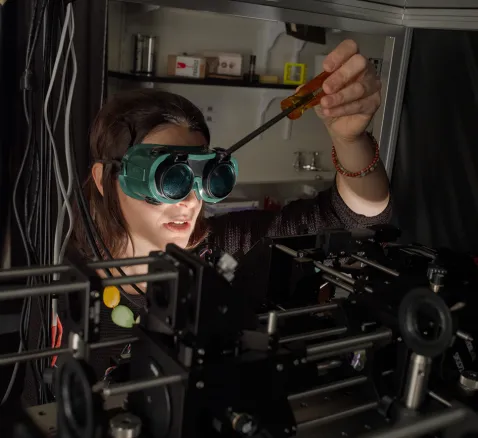Exploring the range of Yale Engineering Senior Projects
Written by Natalie Haase '27
The senior thesis is a hallmark of the Yale experience. In the engineering disciplines, theses take many forms, reflecting the diversity and depth of research within each field. While some departments emphasize collaborative projects, others encourage students to pursue independent research. This article highlights a senior thesis project from each undergraduate discipline within the Yale School of Engineering & Applied Science, showcasing the innovative work of students in Applied Physics, Biomedical Engineering, Chemical Engineering, Computer Science, Electrical & Computer Engineering, Environmental Engineering, and Mechanical Engineering. Through these projects, students address real-world challenges, push the boundaries of their fields, and contribute to the ongoing dialogue in science and technology.
The following projects highlight the breadth of engineering research taking place across Yale's campus, representing just a selection of the many innovative senior projects being pursued by students.
Applied Physics
Silicon Photocatalyst for Seawater Decarbonization and Production of Syngas
Elijah Bakaleynik '25
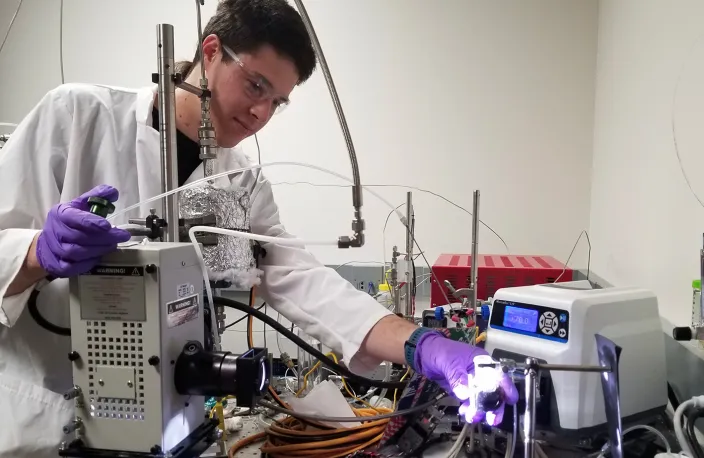
Elijah Bakaleynik, a senior studying Applied Physics (B.S.) with a certificate in Energy Studies, is helping develop cutting-edge climate solutions in Prof. Shu Hu’s lab for his senior project. His work focuses on designing a floating solar array that converts carbon dioxide dissolved in seawater into syngas, a precursor for carbon neutral fuels, such as methanol or kerosene, which syngas may be “upgraded” to, an additional step that other members of the lab are working on. The photocatalytic device could act as a sustainable “ocean oil rig,” reducing ocean acidification while helping decarbonize sectors such as aviation and shipping.
“It’s pretty much my holy grail of interesting science that is also directly building solutions for the climate crisis,” Bakaleynik says.
To be viable, the system must absorb sunlight efficiently, catalyze chemical reactions selectively, and operate for thousands of hours—all while being scalable and cost-effective. Bakaleynik has worked on modifying the photo absorber surface with catalysts and designing stable test protocols to push the technology forward.
After graduation in May, he hopes to join a ClimateTech startup to learn how lab research becomes deployable infrastructure. He expressed sincere gratitude with regards to lab mates, mentors, and classmates for “showing me what’s possible and always being willing to explain the next hard thing.”
Biomedical Engineering
Thyroid Hormone-Induced Human Troponin I Maturation in Engineered Heart Tissue
Jack Sendek '25
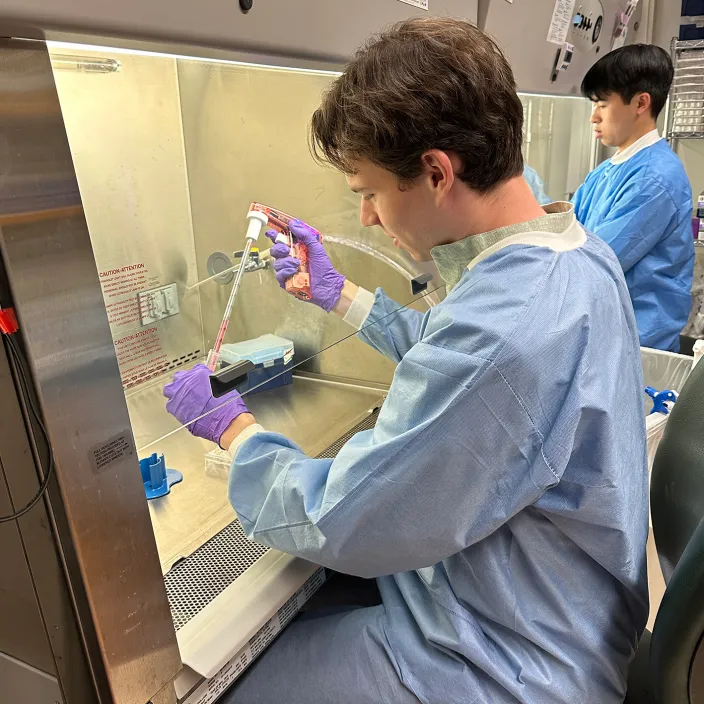
Jack Sendek is a senior studying Biomedical Engineering. His project focuses on how to make lab-grown heart tissue behave more like the real thing. In Prof. Stuart Campbell’s Integrative Cardiac Biomechanics Lab, he engineers tiny pieces of heart muscle using human stem cells and a pig-derived scaffold to investigate a key developmental process: the switching of a protein called Troponin I, which naturally occurs after birth in healthy hearts but hasn’t yet been reliably replicated in engineered tissue.
The main finding Sendek shared is that thyroid hormone can trigger this switch, helping lab-grown tissues better mimic the biology of real human hearts—which could improve how scientists model heart disease and test new drugs.
A distance runner on the Yale Track Team, Sendek brings the same precision and persistence from athletics to the lab. After graduation, he will attend the NYU Grossman School of Medicine, with a focus on Cardiology.
Chemical Engineering
Alkaline Water Electrolysis (AWE) Plant for Sustainable Hydrogen Production: Technical, Economic and Environmental Impact Assessment
Chemical Engineering ’25 Class
Members of the class: Maya Alvear, Gaukhar Alzhanova, Sherrie Azamatova, Maria Beebe, Zubin Birnbach, Anne-Amélie Campant, Neil Kadian, Calista Krass, Marcelo Lejuene, James Licato, Nicolas Liu, Halyn Mackenzie, Luke Neal, Zaneta Otoo, Ellie Rappole, Madelena Ruedaflores, Abrar Sheikh, and Christian Tamez.
This year’s Chemical Engineering senior project, guided by Dr. Yehia Khalil, is a collaborative classwide effort focused on designing and assessing an industrial-scale alkaline water electrolysis (AWE) plant for sustainable hydrogen production. The project seeks to explore AWE's potential as a green alternative to the conventional, fossil-based methods of hydrogen production, a critical step toward decarbonizing energy systems. The team’s work integrates technical, economic, and environmental analyses to assess the viability of AWE. They have used Aspen HYSYS to simulate a 35 MW plant and applied tools like Pugh’s matrix and MACBETH for a comprehensive comparison of hydrogen production technologies. Key considerations include safety assessments, equipment cost estimation, and the levelized cost of hydrogen (LCOH) under various operational scenarios.
The inspiration behind the project stems from the growing need to transition to cleaner energy sources. With most hydrogen still produced through carbon-intensive methods, the team aims to showcase AWE's potential as a scalable, cost-effective, and environmentally friendly alternative. By pairing AWE with renewable energy sources, such as wind power, the project envisions a future where low-emission hydrogen production becomes a reality, advancing both sustainability and the circular economy.
Computer Science
Finding and Imaging Dual Active Galactic Nuclei (AGNs)
Julia Levy '25
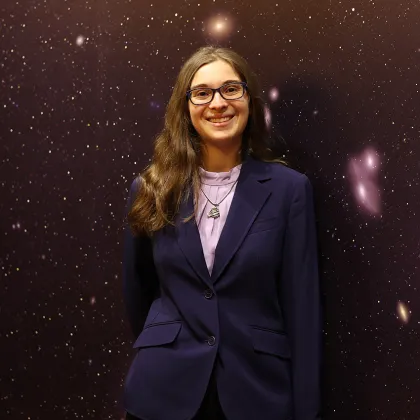
Julia Levy, a Computer Science and Astrophysics double major from Michigan, is finalizing her senior thesis titled "Finding and Imaging Dual Active Galactic Nuclei (AGNs)." Under the mentorship of Professor Meg Urry, Levy is developing a catalog using the IllustrisTNG simulation code to analyze pairs of black holes in close proximity. This catalog will be the first to compare observed gravitational wave signals with simulated dual AGNs. Levy’s goal is to train a Convolutional Neural Network to model real-world images, with the broader aim of exploring the evolution of galaxy mergers through the behavior of their constituent black holes.
Levy has leveraged her time at Yale to explore cutting-edge scientific computing applications. Her research, which bridges computer science and astrophysics, seeks to push forward our understanding of extragalactic phenomena. Inspired by the work of Christina Teik ’24, a fellow executive board member of the Yale Astronomical Society, Levy plans to continue her research journey post-graduation. Her advisors for this project include Professor Urry, Lecturer Sohee Park, and Dr. Antonio J. Porras-Valverde.
Electrical & Computer Engineering
Tissue Testing Devices
Jack Di Palo '25
Jack Di Palo is a senior in Electrical Engineering with a great interest in building and designing innovative devices. For his senior project, Di Palo is working on two key projects that blend engineering with medicine. The first, a lung compliance device, uses pressure and flow sensors to measure static lung compliance (volume/pressure). This device helps determine how easily the lung inflates at a given pressure, which is critical for setting ventilator parameters, and understanding progression of certain pathologies such as pulmonary fibrosis. As Di Palo puts it, "I just build stuff," but his work holds real-world applications with a direct impact on patient care.
His second project focuses on improving upon a planar biaxial tissue testing device used to obtain the stress-strain relationship of various tissues. He works on the LabVIEW interface with the goal of eliminating manual post-processing of data in favor of an "online" local strain calculation. This project aids in understanding how tissues deform under stress and could have significant implications for surgical procedures and tissue engineering.
Di Palo’s work is guided by Dr. Edward Manning, who runs a Biophysics Lab at the Yale School of Medicine. After graduation, he plans to attend medical school, aiming to pursue a career in surgery, where his background in engineering will continue to influence his approach to healthcare innovation.
Environmental Engineering
Boiling Down Gas-Phase Cooking-Related Emissions Profiles in New York City
Anna Oehlerking
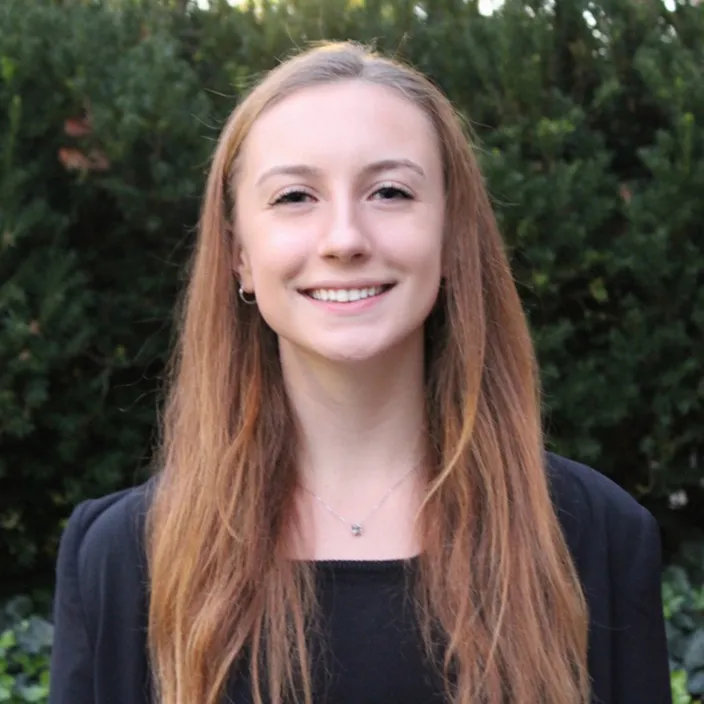
Anna Oehlerking, a senior majoring in Environmental Engineering with certificates in Energy Studies and Data Science, has long been inspired by her love of science and the outdoors, having grown up in a small town near Duluth, Minnesota. This passion led her to Yale, where she has focused on the intersection of environmental science and social equity.
For her senior project, Oehlerking is addressing a critical gap in urban air pollution research. Her work with in Prof. Drew Gentner's Lab and the NOAA/AEROMMA campaign explores the emissions from cooking—ranging from restaurants to household kitchens. Despite cooking being a major contributor to urban air pollution, it is often overlooked in studies. By investigating the disconnect between cooking-related aerosols and gases, her project aims to improve understanding of these emissions in New York City. As she explains, “It’s crucial to understand where these emissions come from so we can reduce their impact on human health.”
After graduation, Oehlerking will begin her PhD studies at Northwestern University, where she plans to further explore air pollution models. Her career goal is to develop strategies for mitigating environmental impacts, particularly in underserved communities affected by air pollution.
Mechanical Engineering
Modular Search and Rescue Drone
Dom Alberts, Roberto Groza, Samantha Lorr & Elena Wittemyer
The Modular Search & Rescue Drone project, developed by a team of four senior Mechanical Engineering students, aims to enhance the capabilities of autonomous search and rescue operations. The team worked in Prof. Ian Abraham’s Intelligent Autonomy Lab to create a drone platform equipped with two innovative modular attachments—a gripper and a perching claw—both designed for real-world application in rescue scenarios. These modules can be easily attached and detached from the drone’s body, enabling it to adapt quickly to different missions without the need for tools. The gripper is a flexible, pneumatically-actuated claw capable of grasping and delivering essential supplies, such as an epi-pen, while the perching claw allows the drone to rest on vertical surfaces like pipes or tree branches, conserving battery life.

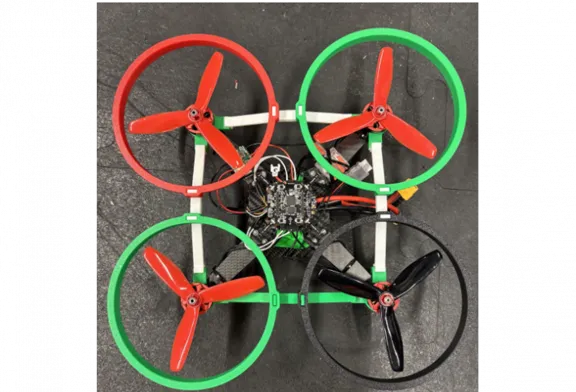
Left: Mechanical Engineering students (L-R) Roberto Groza, Dom Alberts, Elena Wittemyer, Samantha Lorr, who all worked together on the drone. Right: The team's Modular Search & Rescue Drone
The members of the group are: Dom Alberts, a London native with a passion for sustainable engineering, who will be joining Cosentini Associates as a Mechanical Engineer; Elena Wittemyer from Steamboat Springs, CO, who will pursue a Ph.D. in Aeronautics and Astronautics at Stanford; Roberto Groza from Ft. Lauderdale, FL, who has a strong background in robotics and prototyping; and Samantha Lorr from Coronado, CA, who will be starting in Strategy & Product at Jane Street postgrad.
Their project will support future research efforts in the Intelligent Autonomy Lab and contribute to the ongoing evolution of autonomous robotics.
More Details
Published Date
Apr 28, 2025






